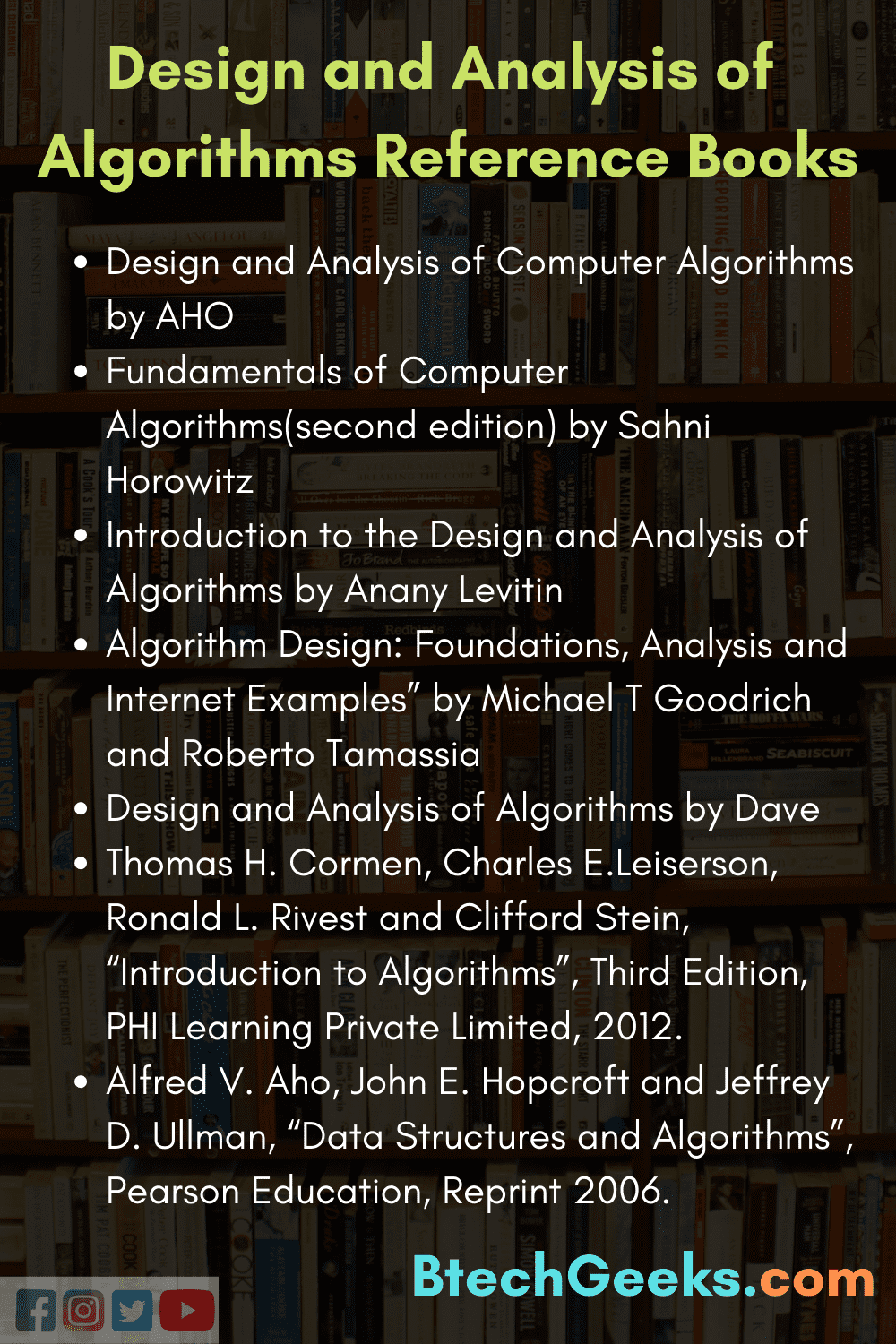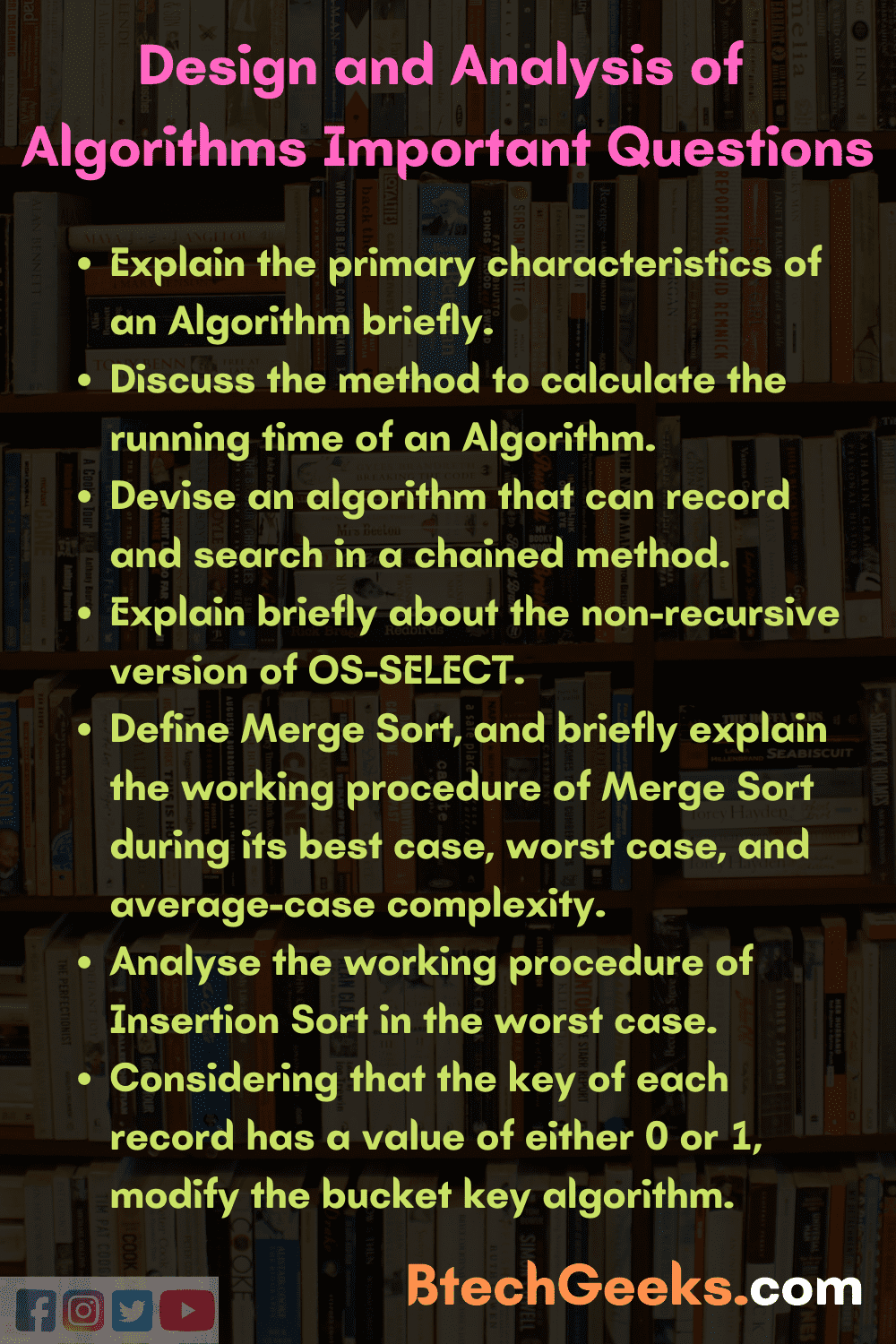Design and Analysis of Algorithms PDF by Udit Agarwal: Are you on the hunt to get hold of the Design and Analysis of Algorithms Pdf By Udit Agarwal? You can access all the essential concepts and chapters on the Design And Analysis of Algorithms Pdf By Udit Agarwal from this article and enhance your preparation process of essential concepts.
The Article on Design and Analysis of Algorithms Pdf By Udit Agarwal acts as the principal source of reference to improve and enhance preparation and secure better grades. Students can access and download the Design and Analysis of Algorithms Pdf By Udit Agarwal as per the latest curriculum for free from this article. Students can refer to the Big Data Lecture Notes For CSE as per the latest and updated syllabus from this article.
The Design and Analysis of Algorithms Pdf By Udit Agarwal give students a major advantage as they acquire the latest and updated chapter-wise syllabus and the list of important questions over other regular notes. Students can download the Design And Analysis Of Algorithms Notes Pdf By Udit Agarwal from here and improvise their preparation approach with the best and updated study resources and secure better grades.
- Introduction to Design and Analysis Of Algorithms
- CS-Design and Analysis of Algorithms PDF by Udit Agarwal Free Download
- Design and Analysis of Algorithms Syllabus
- List of Design and Analysis of Algorithms Important Questions
- Design and Analysis of Algorithms Reference Books
- Explain the definition of Algorithms briefly?
- Derive the classification of Algorithms?
- How is Design And Analysis Of Algorithms Pdf By Udit Agarwal useful?
- Name a few important questions from Design And Analysis Of Algorithms Pdf By Udit Agarwal Book?
Introduction to Design and Analysis of Algorithms
Algorithm design goodrich pdf: An Algorithm is defined as a set of operation or computational steps or instructions designed to solve problems performing data processing, organise structures, calculation, and automated reasoning tasks. It is an efficient method that expresses a finite amount of space and time and represents a solution in a particular manner. An algorithm is independent of any programming language through the remembrance of the past results to obtain new results.
The important aspect of algorithm design is the creation of an efficient algorithm to resolve specific or general problems through the use of minimum space and time in an efficient manner. The primary characteristics of an algorithm are- Finiteness, Input, Output, Definiteness, and Effectiveness.
However, an algorithm is different from a Pseudocode as it defines a well-defined series of steps and resolves a specific problem. Algorithms are generally written in Plain English or simple languages.
CS-Design and Analysis of Algorithms PDF by Udit Agarwal Free Download
Graduates studying Computer Science or Electrical Engineering course programme can access the Design And Analysis Of Algorithms Pdf By Udit Agarwal briefed in this article. Through the pdf, students can better prepare to help themselves secure better grades.
Students can download and access the Design And Analysis Of Algorithms Pdf By Udit Agarwal and other reference sources and refer to it whenever during the preparation or revision process for free.
Through dedicated use and utilisation of the Design And Analysis Of Algorithms Pdf By Udit Agarwal as a source reference will help each candidate get a better brief and comprehension of all the enlisted concepts and change their score game.
Here, are a list of a few important notes on Design And Analysis Of Algorithms Pdf By Udit Agarwal for a thorough preparation of the Computer Science course programme-
- Design And Analysis Of Algorithms Pdf By Udit Agarwal
- Design And Analysis Of Algorithms Pdf By Udit Agarwal Chapter-Wise Division
Design and Analysis of Algorithms Reference Books
- Alfred V. Aho, John E. Hopcroft and Jeffrey D. Ullman, “Data Structures and Algorithms”, Pearson Education, Reprint 2006.
- Thomas H. Cormen, Charles E.Leiserson, Ronald L. Rivest and Clifford Stein, “Introduction to Algorithms”, Third Edition, PHI Learning Private Limited, 2012.
- Anany Levitin, “Introduction to the Design and Analysis of Algorithms”, Third Edition, Pearson Education, 2012.
- Donald E. Knuth, “The Art of Computer Programming”, Volumes 1& 3 Pearson Education, 2009. 4. Steven S. Skiena, “The Algorithm Design Manual”, Second Edition, Springer, 2008.
- Design and Analysis of Computer Algorithms by AHO
- Fundamentals of Computer Algorithms(second edition) by Sahni Horowitz
- Introduction to the Design and Analysis of Algorithms by Anany Levitin
- Algorithm Design: Foundations, Analysis and Internet Examples” by Michael T Goodrich and Roberto Tamassia
- Design and Analysis of Algorithms by Dave

Design and Analysis of Algorithms Syllabus
The Design And Analysis Of Algorithms Pdf By Udit Agarwal Content gives an initial idea and a basic outline of the important topics or concepts in the book to enhance and effectual is student’s preparation or revision process.
The Design and Analysis of Algorithms Pdf By Udit Agarwal Content give students a clear and brief idea of what to study and how to study the concepts. The article provides a detailed view of the Design and Analysis of Algorithms Pdf By Udit Agarwal Content, taking into consideration of every student’s requirements and needs. Here, you will avail the chapter-wise breakdown of all the important topics enlisted under each chapter so that candidates allot enough time to each topic accordingly.
Graduates must ensure to envelop all the important topics before attempting the Design And Analysis of Algorithms exam so that the paper is reasonably answerable and so that students prevent from wasting unnecessary time on redundant topics.
The updated chapter-wise breakup of the Design And Analysis Of Algorithms Pdf By Udit Agarwal Content is as follows-
| Chapter I- Introduction to Algorithm | Chapter II- Growth of Functions |
|
|
| Chapter III- Recorrances | Chapter IV- Analysis of Simple Sorting Algorithms |
|
|
| Chapter V- Merge Sort | Chapter VI- Heap Sort |
|
|
| Chapter VII- Quick Sort | Chapter VIII- Sorting in
Linear Time |
|
|
| Chapter IX- Medians and Order Statistics | Chapter X-Dictionaries and Hash Tables |
|
|
| Chapter XI-Elementary Data Structures | Chapter XII- Binary Search Tree |
|
|
| Chapter XIII- AVL Tree | Chapter XIV- Spray Trees |
|
|
| Chapter XV- Red-Black Trees | Chapter XVI- Augmenting Data Structures |
|
|
| Chapter XVII- B-Trees | Chapter XVIII- Binomial Heaps |
|
|
| Chapter XIX- Fibonacci Heaps | Chapter XX- Data Structures for Disjoint Sets |
|
|
| Chapter XXI- Dynamic Programming | Chapter XXII- Greedy Algorithms |
|
|
| Chapter XXIII- Backtracking | Chapter XXIV- Branch and Bound |
|
|
| Chapter XXV-Amortized Analysis | Chapter XXVI- Elementary Graphs Algorithms |
|
|
| Chapter XXVII- Minimum Spanning Tree | Chapter XXVIII- Single Source Shortest Paths |
|
|
| Chapter XXIX- All-Pairs Shortest Paths | Chapter XXX- Maximum Flow |
|
|
| Chapter XXXI- Sorting Networks | Chapter XXXII- Algorithms for Parallel Computers |
|
|
| Chapter XXXIII-Matrix Operations | Chapter XXXIV- Number-Theorthic Algorithms |
|
|
| Chapter XXXV- Polynomials and the FFT | Chapter XXXVI- String Matching |
|
|
| Chapter XXXVII- Computational Geometry | Chapter XXXVIII- NP-Completeness |
|
|
| Chapter XXXIX- Approximate Algorithms | Chapter XXXX- Randomized Algorithm |
|
|
List of Design and Analysis of Algorithms PDF by Udit Agarwal Important Questions
Candidates pursuing the Computer Science or Electrical Engineering course programme can access the article Design And Analysis Of Algorithms Pdf By Udit Agarwal and read through the list of all the essential questions mentioned below for the course programme. All the provided review questions aim to help candidates excel in their examinations.
- Explain the primary characteristics of an Algorithm briefly.
- Discuss the method to calculate the running time of an Algorithm.
- Discuss the INSERTION SORT on an array A-(41,31,69,16,38,62) with a neat-labelled diagram.
- Analyse the working procedure of Insertion Sort in the worst case.
- With the application of Merge Sort, Sort the following list- 70, 80, 40, 50, 60, 12, 35, 95, 10
- Define Merge Sort, and briefly explain the working procedure of Merge Sort during its best case, worst case, and average-case complexity.
- Discuss the heap-Sort Algorithm of the following input with a neat-labelled diagram (2, 5, 16,4, 10,23,39, 18,26,15)
- Consider that the running time of all the elements of array A having the same value, elucidate on the running time of the QUICK SORT.
- Considering that the key of each record has a value of either 0 or 1, modify the bucket key algorithm.
- Devise an algorithm that can record and search in a chained method.
- Write a C program that can break a single circularly-linked list into two circularly linked lists.0
- 25Describe the outlook of a splay tree if the keys are accessed in increasing order.
- Illustrate how an AVL tree can be designed as a Red-Black Tree.
Illustrate with a neat-labelled diagram of a Red-Black Tree disconnected to an AVL tree. - Explain briefly about the non-recursive version of OS-SELECT.

FAQ’s on Design and Analysis of Algorithms PDF by Udit Agarwal
Question 1.
Explain the definition of Algorithms briefly?
Answer:
An Algorithm is a sequence or a set of computational rules that transform input into output or carries the calculation either on a machine or by hand. Through algorithms and abstraction can be extracted on a physical machine.
Question 2.
Derive the classification of Algorithms?
Answer:
Algorithms, when grouped, adopt a similar structure like a problem-solving technique. A few Algorithm types to consider are-
- Greedy Algorithms
- Randomized Algorithms
- Divide and Conquer Algorithms
- Recursive Algorithms
- Branch and Bound Algorithms
- Backtracking Algorithms
- Brute Force Algorithms
- Dynamic Programming Algorithms
Question 3.
How is Design And Analysis Of Algorithms Pdf By Udit Agarwal useful?
Answer:
The Design And Analysis Of Algorithms Pdf By Udit Agarwal Book provide a comprehensive understanding of all the important concepts. The pdf even presents mock exercises to simply and better a student’s preparation or revision process. The book gives a detailed view of all aspects of Design And Analysis Of Algorithms.
Question 4.
Name a few important questions from Design And Analysis Of Algorithms Pdf By Udit Agarwal Book.
Answer:
- Explain the primary characteristics of an Algorithm briefly.
- Discuss the method to calculate the running time of an Algorithm.
- Consider that the running time of all the elements of array A having the same value, elucidate on the running time of the QUICK SORT.
- Considering that the key of each record has a value of either 0 or 1, modify the bucket key algorithm.
- Devise an algorithm that can record and search in a chained method.
Conclusion
The article on Design And Analysis of Algorithms Pdf by Udit Agarwal is a credible and reliable source of reference that aims to help and enhance student’s knowledge and understanding of the subject. The article on Design And Analysis of Algorithms Pdf By Udit Agarwal offers students the best Design And Analysis of Algorithms Notes, exercises, and the list of all important questions simply and comprehensively.

